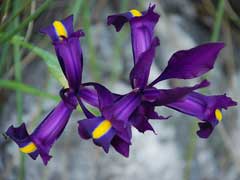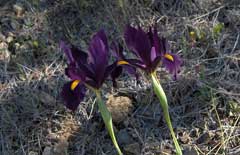 |
|
http://www.flickr.com/photos/montuno/2282850682/ |
 |
| http://picasaweb.google.com/lh/photo/vs27p_fvtdjCBP4PvRf2RA |
Translate this page:
Summary
Physical Characteristics

 Iris filifolia is a BULB growing to 0.5 m (1ft 8in). It is in leaf from October to July, in flower in June. The species is hermaphrodite (has both male and female organs) and is pollinated by Insects. The plant is self-fertile.
Iris filifolia is a BULB growing to 0.5 m (1ft 8in). It is in leaf from October to July, in flower in June. The species is hermaphrodite (has both male and female organs) and is pollinated by Insects. The plant is self-fertile.
Suitable for: light (sandy) and medium (loamy) soils and prefers well-drained soil. Suitable pH: mildly acid, neutral and basic (mildly alkaline) soils. It cannot grow in the shade. It prefers dry or moist soil and can tolerate drought.
UK Hardiness Map
US Hardiness Map
Synonyms
I. juncea.
Plant Habitats
Cultivated Beds; East Wall. In. West Wall. In.
Edible Uses
Edible Parts: Root
Edible Uses:
Bulb - cooked. Used as a vegetable[22, 46, 61, 105].
References More on Edible Uses
Medicinal Uses
Plants For A Future can not take any responsibility for any adverse effects from the use of plants. Always seek advice from a professional before using a plant medicinally.
None known
References More on Medicinal Uses
The Bookshop: Edible Plant Books
Our Latest books on Perennial Plants For Food Forests and Permaculture Gardens in paperback or digital formats.

Edible Tropical Plants
Food Forest Plants for Hotter Conditions: 250+ Plants For Tropical Food Forests & Permaculture Gardens.
More

Edible Temperate Plants
Plants for Your Food Forest: 500 Plants for Temperate Food Forests & Permaculture Gardens.
More

More Books
PFAF have eight books available in paperback and digital formats. Browse the shop for more information.
Shop Now
Other Uses
References More on Other Uses
Cultivation details
Prefers a sunny position[42, 79]. Requires a well-drained soil and needs to be kept dry in summer[200]. Established plants are drought tolerant[190]. Plants are best grown in a cold frame in Britain to protect them from summer damp[79]. Bulbs should be planted 7 - 10cm deep and will require feeding after they have flowered[79]. The leaves appear in the autumn and require protection from severe frosts[90]. Members of this genus are rarely if ever troubled by browsing deer or rabbits[233].
References Carbon Farming Information and Carbon Sequestration Information
Temperature Converter
Type a value in the Celsius field to convert the value to Fahrenheit:
Fahrenheit:
The PFAF Bookshop
Plants For A Future have a number of books available in paperback and digital form. Book titles include Edible Plants, Edible Perennials, Edible Trees,Edible Shrubs, Woodland Gardening, and Temperate Food Forest Plants. Our new book is Food Forest Plants For Hotter Conditions (Tropical and Sub-Tropical).
Shop Now
Plant Propagation
Seed - best sown as soon as it is ripe in a cold frame. Stored seed should be sown as early in the year as possible in a cold frame. Prick out the seedlings into individual pots when they are large enough to handle and grow them on in the greenhouse or cold frame for their first year. Plant out into their permanent positions in late spring or early summer. Division, best done after flowering. Very easy, larger clumps can be replanted direct into their permanent positions, though it is best to pot up smaller clumps and grow them on in a cold frame until they are rooting well. Plant them out in the spring.
Other Names
If available other names are mentioned here
Native Range
EUROPE: Spain (southwest) AFRICA: Morocco
Weed Potential
Right plant wrong place. We are currently updating this section.
Please note that a plant may be invasive in one area but may not in your area so it's worth checking.
Conservation Status
IUCN Red List of Threatened Plants Status :

| Related Plants
|
| Latin Name | Common Name | Habit | Height | Hardiness | Growth | Soil | Shade | Moisture | Edible | Medicinal | Other |
| Albizia lebbeck | Siris Tree, Woman's Tongue, East Indian Walnut | Tree | 15.0 |
10-11
| F | LMH | N | DM | 1 | 2 | 4 |
| Albizia lucidior | Potka siris tree | Tree | 15.0 |
10-12
| F | LMH | SN | M | 0 | 0 | 3 |
| Albizia procera | White Siris, Tall Albizia, Forest Siris | Tree | 25.0 |
10-12
| F | LMH | N | M | 1 | 2 | 4 |
| Bobartia indica | Rush Iris | Perennial | 0.6 |
7-10
| S | L | N | DM | 0 | 0 | 1 |
| Gynandriris sisyrinchium | Spanish Nut | Perennial | 0.2 |
7-10
| | MH | SN | DM | 1 | 0 | |
| Iris cristata | Crested Iris, Dwarf crested iris | Perennial | 0.2 |
5-9
| M | LM | SN | M | 1 | 1 | |
| Iris decora | | Perennial | 0.3 |
-
| | LM | N | DM | 0 | 1 | |
| Iris douglasiana | Mountain Iris, Douglas iris | Perennial | 0.3 |
6-9
| | LM | SN | DMWe | 0 | 0 | 1 |
| Iris ensata | Japanese Water Iris | Perennial | 0.6 |
5-8
| M | LM | N | MWe | 1 | 1 | 2 |
| Iris foetidissima | Stinking Gladwin, Stinking iris, Gladwin Iris | Perennial | 1.0 |
7-10
| M | LMH | FSN | DMWe | 0 | 2 | 3 |
| Iris germanica | Purple Flag, German iris, Orris-root, Tall Bearded German Iris, Bearded Iris | Perennial | 1.0 |
4-10
| M | LM | SN | DM | 1 | 3 | 2 |
| Iris germanica florentina | Orris, Orris-root | Perennial | 0.9 |
5-10
| M | LM | SN | M | 1 | 3 | 3 |
| Iris japonica | | Perennial | 0.6 |
-
| | LM | SN | DM | 1 | 2 | 3 |
| Iris kemaonensis | | Perennial | 0.5 |
-
| | LM | SN | DM | 0 | 2 | |
| Iris macrosiphon | Bowltube Iris | Perennial | 0.2 |
-
| | LM | SN | M | 0 | 1 | 1 |
| Iris missouriensis | Rocky Mountain Iris | Perennial | 0.8 |
0-0
| | LM | SN | MWe | 1 | 2 | 1 |
| Iris pallida | Dalmation Iris, Sweet iris, Fragrant Iris, Zebra Iris | Perennial | 1.0 |
4-10
| M | LM | SN | DM | 2 | 1 | 3 |
| Iris pseudacorus | Yellow Flag, Paleyellow iris | Perennial | 1.5 |
5-8
| M | LM | SN | MWeWa | 1 | 2 | 2 |
| Iris purdyi | Purdy's Iris | Perennial | 0.4 |
-
| | LM | SN | DM | 0 | 0 | 1 |
| Iris sanguinea | Blood iris | Perennial | 0.8 |
5-9
| | LM | SN | MWe | 0 | 1 | 1 |
| Iris setosa | Beachhead Iris, Canada beachhead iris, Wild flag | Perennial | 0.6 |
4-8
| M | LM | SN | MWe | 1 | 1 | 1 |
| Iris sibirica | Siberian Iris | Perennial | 0.6 |
4-9
| F | LM | SN | MWe | 1 | 1 | 1 |
| Iris tectorum | Roof Iris, Wall iris, Japanese Roof, White Root Iris | Perennial | 0.3 |
5-9
| M | LM | SN | DM | 1 | 0 | |
| Iris tenax | Tough-Leaf Iris, Klamath iris | Perennial | 0.3 |
0-0
| | LM | SN | DM | 0 | 1 | 2 |
| Iris versicolor | Blue Flag, Harlequin blueflag | Perennial | 0.6 |
4-8
| | LM | SN | MWe | 0 | 3 | 2 |
| Solanum tuberosum | Potato, Irish potato | Perennial | 1.0 |
7-10
| | LMH | N | M | 5 | 2 | 3 |
| Tagetes filifolia | Irish Lace | Annual | 0.4 |
8-11
| F | LMH | N | DM | 1 | 0 | 2 |
|
Growth: S = slow M = medium F = fast. Soil: L = light (sandy) M = medium H = heavy (clay). pH: A = acid N = neutral B = basic (alkaline). Shade: F = full shade S = semi-shade N = no shade. Moisture: D = dry M = Moist We = wet Wa = water.
Now available:
Food Forest Plants for Mediterranean Conditions
350+ Perennial Plants For Mediterranean and Drier Food Forests and Permaculture Gardens.
[Paperback and eBook]
This is the third in Plants For A Future's series of plant guides for food forests tailored to
specific climate zones. Following volumes on temperate and tropical ecosystems, this book focuses
on species suited to Mediterranean conditions—regions with hot, dry summers and cool, wet winters,
often facing the added challenge of climate change.
Read More
Expert comment
Author
Boiss.
Botanical References
50200
Links / References
For a list of references used on this page please go here
Readers comment
| Add a comment |
|
If you have important information about this plant that may help other users please add a comment or link below. Only comments or links that are felt to be directly relevant to a plant will be included. If you think a comment/link or information contained on this page is inaccurate or misleading we would welcome your feedback at [email protected]. If you have questions about a plant please use the Forum on this website as we do not have the resources to answer questions ourselves.
* Please note: the comments by website users are not necessarily those held by PFAF and may give misleading or inaccurate information.
To leave a comment please Register or login here All comments need to be approved so will not appear immediately.
|
|